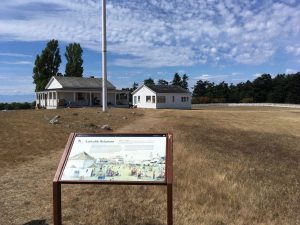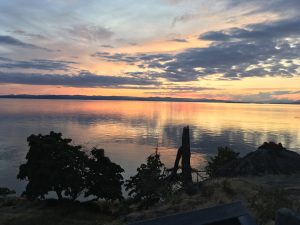ECW Weekender – Civil War History in the Pacific Northwest: San Juan Island
It was a stifling day as Asha and I walked the trail leading to American Camp. Despite the warm weather, we had a wonderful view from the southern point of San Juan Island. It’s hard to believe that this quaint island was at the center of the boundary dispute 160 years ago. During the summer of 1859, an American settler murdered a British settler’s boar, which led to a confrontation that will be forever remembered as the Pig War. Some people have poked fun at this bloodless “war” that began over a pig, but there was nothing humorous about the quarrel. It nearly led to a war between Great Britain and the United States.
In June 1846, American and British commissioners signed the Treaty of Oregon, which set the boundary between Canada and the United States on the 49th parallel. This invisible line ran from the Rocky Mountains to a “middle channel” which separated the mainland (Washington Territory) from Vancouver Island. From the channel, it proceeded south to the Strait of Juan de Fuca and west to the Pacific Ocean. The “middle channel” turned out to be two separate channels—the Haro Strait and the Rosario Strait. This oversight left San Juan Island dead center of the 49th parallel.

The Americans and the British claimed San Juan Island as their territory. The Governor of Vancouver Island, Sir James Douglas, viewed San Juan Island as an extension of Vancouver Island. Neither side could lawfully claim it as their own. But this didn’t stop American and British settlers from arriving and settling on the island.
The British settled on San Juan Island first. By the time the Americans arrived, the British residents felt that the Yankees were squatting on their lands, creating an awkward and tense situation. On June 15, 1859, the disagreement ripened into hostility when an American settler, Lyman Cutlar, killed a Berkshire boar owned by Charles J. Griffin of the Hudson’s Bay Company, after he caught it rooting on his land. The British authorities threatened to arrest Cutlar and banish all the Americans from the island.
The American settlers sought protection from the commander of the Department of Oregon, Brigadier General William S. Harney. The hotheaded Tennessean dispatched 34-year-old Captain George E. Pickett with Co. D, Ninth Infantry from Fort Bellingham to set up camp on the island. On July 27, 1859, Pickett arrived at Griffin Bay with 64 men. While it’s unlikely, some have claimed that Harney and Pickett were collaborating to start a war against Great Britain. Regardless if there was a greater motive intended, Pickett became embroiled in a dispute that could have changed the course of history, just like his charge at Gettysburg in the summer of 1863.
Sir James Douglas countered Harney’s impetuous move with an equally heedless act. He sent the 31-gun steam frigate, HMS Tribune, under the command of 33-year-old Captain Geoffrey P. Hornby, to oppose any attempt the Americans made to land more troops or to construct fortifications. The governor general’s superior, the Commander-in-Chief of the Pacific Station, Rear Admiral Robert Lambert Baynes, was away, leaving Douglas to do as he wished with the British forces in the Pacific Northwest.

Hornby arrived two days after Pickett established his camp. The Royal Navy captain was surprised to find that Pickett ill-advisedly failed to fortify or entrench his camp. The Tribune’s guns could have easily decimated the vulnerable Americans. Pickett’s poor judgment reinforced the common assertion shared by some historians that he was never much of a soldier.
Neither government wanted a war, but Harney and Douglas were steering their respective countries in that direction. The delay in communication between Washington and London allowed the dispute to spiral out of control before the governments could respond. Luckily, Hornby disobeyed Douglas’s orders long enough for Baynes to return and assume command, suspending the belligerent Douglas. Likewise, when President James Buchanan found out what was transpiring on the island, he sent Major General Winfield Scott to oust Harney and smooth things over with the British. It took Scott six-weeks to reach San Juan Island. In November, the two sides agreed to jointly occupy the island until the boundary dispute could be settled by treaty.

As Asha and I explored the parade ground, laundress quarters, officers’ quarters, and the redoubts at American Camp, we passed a large group of tourists. “There’s Mike Vouri,” Asha said to me. She recognized him from his headshot on the back of his book. I didn’t distinguish him with a baseball cap on, but thankfully she did. I read Vouri’s book, The Pig War: Standoff at Griffin Bay, on the plane ride from Cleveland, Ohio, to Spokane, Washington, and was hoping that I would get a chance to get his autograph. This was my chance.
I sprinted over to our rental car, grabbed my copy of The Pig War: Standoff at Griffin Bay, and made my way back into the air-conditioned visitor center. By the time I got there, I was dripping with sweat. I approached Vouri and asked him if he would be kind enough to sign my book, which he did. We chatted for a few moments about the poor location of Pickett’s campsite. He couldn’t have been a nicer guy. The encounter with Vouri made my afternoon.

We drove over to English Camp located at Garrison Bay, thirteen miles north of American Camp. It was shaded by trees and much cooler here. The British knew how to pick a campsite. After investigating the parade ground, barracks, blockhouse, commissary, and garden, we hiked to the camp’s cemetery located on Young Hill. While it was small, the tranquil cemetery was well worth the visit.
The joint military occupation of San Juan Island ended after twelve years when Kaiser Wilhelm I of Germany and a three-man commission decided the island should be handed over to the United States. Had war broken out between the United States and Great Britain, it’s unlikely that a civil war would have occurred in the United States, at least in 1861. Instead, James Buchanan might have been the president remembered for calling for 75,000 volunteers, not Lincoln, to fight the British rather than to put down the rebellion.

Recommended Reading:
Murray, Keith. The Pig War. Tacoma: Washington State Historical Society, 1968.
Vouri, Mike. The Pig War: Standoff at Griffin Bay. Seattle, WA: Discover Your Northwest, 2013.
Vouri, Mike. Outpost of Empire: the Royal Marines and the Joint Occupation of San Juan Island. Northwest Interpretive Association, Seattle, WA, 2004.
Address:
San Juan Island National Historic Park
American Camp Visitor Center
4668 Cattle Point Rd.
Friday Harbor, WA, 98250
English Camp Visitor Center
3905 West Valley Rd.
Friday Harbor, WA, 98250


Thanks for this nice description of what happened there. Anybody who is interested in visiting the sites is wise to do it during the week or in Spring/Fall. Getting a WSF ferry out of Anacortes on summer weekends is a daunting enterprise. If you want to get in some exercise head over to Orcas and bike up Mt. Constitution.